How to Plant Daffodil
- April 9, 2024
- 0 comment
Daffodils, with their vibrant blooms and easy-care nature, have become a favorite among garden enthusiasts and novices alike. These heralds of spring offer a delightful splash of color, often being one of the first flowers to emerge from the winter slumber. If you’re looking to add these cheerful blossoms to your garden, follow this step-by-step guide to ensure a beautiful display.

List on How To Plant Daffodil
- Choose Your Bulbs
- Timing is Everything
- Selecting the Site
- Planting Your Bulbs
- Water and Mulch
- Spring Care
Choose Your Bulbs
Select high-quality daffodil bulbs from a reputable nursery or garden center. Look for bulbs that are large, firm, and free from any signs of rot or damage. There are numerous varieties of daffodils, ranging in color, size, and blooming time, so choose the ones that best fit your garden’s aesthetic and climate.
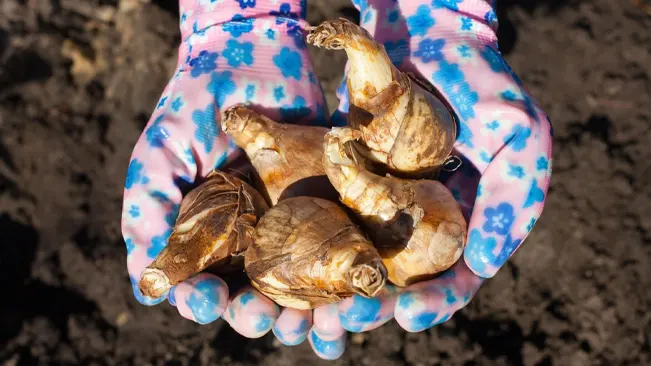
- Inspect the Bulbs: Look for bulbs that are large, firm, and free from any signs of rot or damage. Healthy bulbs are more likely to produce strong, vibrant flowers.
- Consider Varieties: Daffodils come in numerous varieties, each with its own unique characteristics. Consider factors such as color, size, and blooming time when selecting bulbs to ensure they complement your garden’s aesthetic and climate.
- Check for Firmness: Gently squeeze the bulbs to check for firmness. Bulbs that feel soft or squishy may be damaged or past their prime.
- Avoid Moldy Bulbs: Steer clear of bulbs that show any signs of mold or fungus growth. These could indicate underlying issues that may affect the bulb’s ability to grow and thrive.
- Research Specific Needs: Some daffodil varieties may have specific soil or climate requirements. Take the time to research the needs of the varieties you’re interested in to ensure they will thrive in your garden.
Timing is Everything
- Daffodils are typically planted in the fall, about 2-4 weeks before the ground freezes. This allows the bulbs to establish roots before the winter. In milder climates where the ground doesn’t freeze, bulbs can be planted later in the fall. Check your local gardening zone for the optimal planting time in your area.
Selecting the Site
Choose a site that receives at least 6 hours of sunlight daily. Daffodils thrive in well-drained soil, so avoid areas where water tends to pool. If your soil is heavy or clay-like, consider amending it with organic matter such as compost or peat moss to improve drainage.
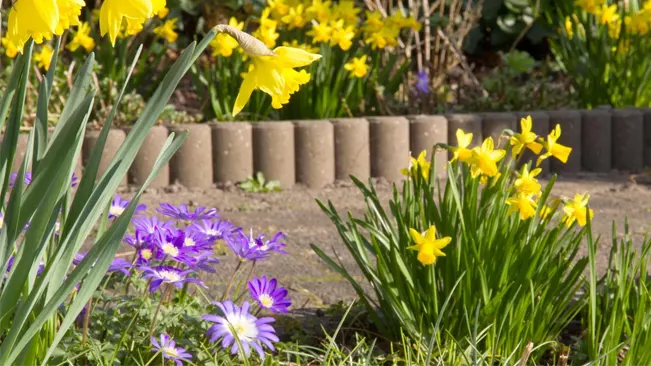
- Sunlight Requirements: Daffodils typically require a good amount of sunlight to thrive. Aim for a site that receives at least 6 hours of sunlight daily. This ensures that the daffodils receive adequate light for photosynthesis, which is essential for their growth and development.
- Soil Drainage: One of the most important factors to consider when selecting a site for daffodils is soil drainage. These flowers prefer well-drained soil and are susceptible to rot if they sit in waterlogged conditions for too long. Therefore, it’s essential to avoid areas where water tends to pool, especially during rainy periods.
- Soil Type: If your soil is heavy or clay-like, it’s beneficial to amend it before planting daffodils. Heavy soil tends to retain water, which can lead to root rot and other issues. Consider adding organic matter such as compost or peat moss to improve soil structure and drainage. This not only helps prevent waterlogging but also provides essential nutrients for the daffodils’ growth.
Planting Your Bulbs

- Choose the Right Spot: Before you start digging, it’s important to select a suitable location for your bulbs. Most bulbs prefer well-drained soil and plenty of sunlight. Take note of the specific sunlight requirements for the type of bulb you’re planting and choose a spot accordingly.
- Prepare the Soil: Once you’ve chosen the perfect spot, prepare the soil by loosening it with a garden fork or shovel. Remove any weeds, rocks, or debris that may hinder the growth of your bulbs.
- Dig Holes or Trenches: Use a garden trowel or shovel to dig holes or a trench that’s about 6 inches deep. As a general rule of thumb, the depth should be roughly 3 times the height of the bulb you’re planting.
- Position the Bulbs: With the holes or trench prepared, it’s time to position the bulbs. Place each bulb in the hole with the pointy end facing up. This is where the stem will emerge, so it’s essential to plant them in the correct orientation.
- Spacing: Space the bulbs about 3-6 inches apart from each other. This will give them enough room to grow without overcrowding. If you’re planting in groups or clusters, make sure to distribute them evenly and provide adequate spacing between each cluster.
Water and Mulch
Watering
After planting bulbs, it’s essential to give them a good watering. This initial watering helps to kickstart root growth and establish the bulbs in their new environment.
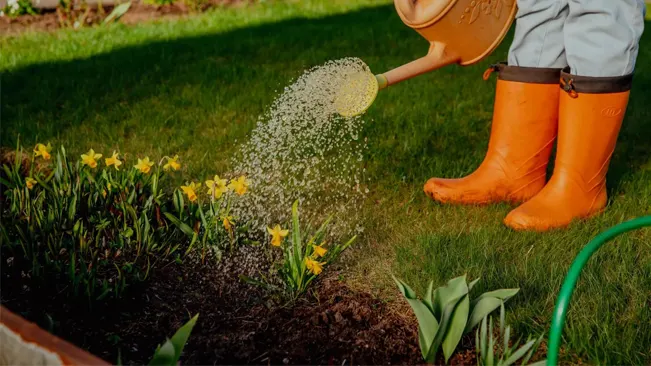
- Thoroughness: Ensure that the soil around the bulbs is evenly moistened. Water should penetrate the soil to reach the root zone where the bulbs are situated.
- Frequency: Initially, bulbs may need frequent watering to keep the soil consistently moist. As they establish themselves and roots develop, you can gradually reduce the frequency of watering.
- Avoid Overwatering: While bulbs need moisture to grow, it’s important not to overwater them. Soggy soil can lead to rot and fungal diseases, which can be detrimental to bulb health.
- Time of Day: Watering in the morning is often recommended as it allows excess moisture to evaporate during the day, reducing the risk of fungal diseases.
- Deep Watering: Aim to water deeply rather than shallowly. Deep watering encourages roots to grow downward, promoting a strong and healthy root system.
Mulching
Mulching is another beneficial practice that can aid in the growth and health of bulbs.
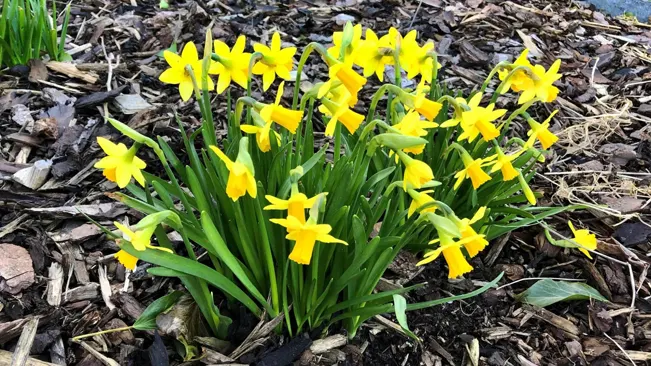
- Moisture Retention: A layer of mulch helps to retain moisture in the soil, reducing the need for frequent watering. This is especially beneficial during hot, dry periods when moisture loss from the soil is high.
- Weed Suppression: Mulch acts as a barrier, suppressing the growth of weeds around the bulbs. This helps to reduce competition for nutrients and moisture, allowing the bulbs to thrive.
- Temperature Regulation: Mulch helps to insulate the soil, providing protection to bulbs from extreme temperatures. In cold climates, mulch can prevent frost heaving, where bulbs are pushed out of the ground by freezing and thawing cycles.
- Soil Improvement: Organic mulches like shredded leaves or bark chips gradually break down over time, enriching the soil with organic matter and nutrients. This improves soil structure and fertility, creating a healthier environment for bulb growth.
Spring Care
Fertilizing
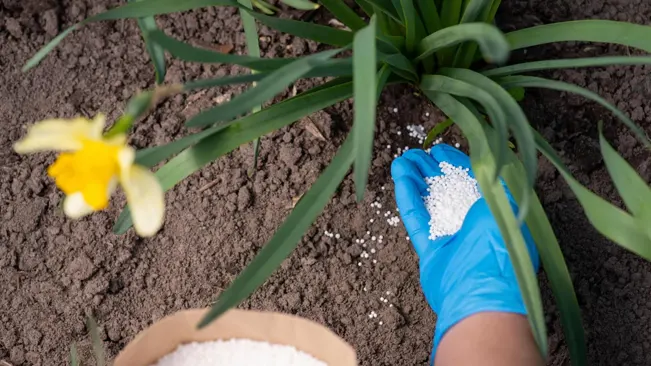
- In the spring, as daffodil shoots start emerging from the soil, it’s a good idea to apply a balanced, slow-release fertilizer. This fertilizer provides essential nutrients to the bulbs, promoting healthy growth and robust blooms. Make sure to follow the instructions on the fertilizer package for proper application rates.
Watering

- While it’s important to keep the soil moist to support daffodil growth, it’s equally crucial not to overwater them. Daffodils prefer well-draining soil, so avoid waterlogging the soil, which can lead to root rot. A deep watering once a week is usually sufficient, but adjust based on weather conditions and soil moisture levels.
Blooming and Foliage Care
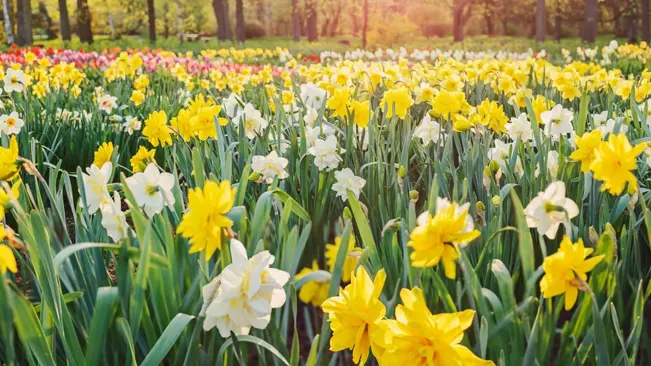
- Once your daffodils have bloomed and showcased their vibrant flowers, it’s tempting to tidy up the garden by removing the foliage. However, it’s crucial to resist this urge. Allow the foliage to naturally die back on its own. This process allows the plant to photosynthesize and store energy in the bulb for next year’s bloom. Removing the foliage prematurely can weaken the bulb and diminish future flowering.
Conclusion
Planting daffodils is a simple and rewarding gardening project that can bring years of springtime joy. By following these steps and providing a little care, you can create a stunning display of these beloved spring flowers in your garden.
FAQs (Frequently Asked Questions)
- When is the best time to plant daffodil bulbs?
- Plant daffodil bulbs in the fall, about 2-4 weeks before the ground freezes. This gives them time to establish roots before the winter. In milder climates, you can plant even later into the fall.
- Plant daffodil bulbs in the fall, about 2-4 weeks before the ground freezes. This gives them time to establish roots before the winter. In milder climates, you can plant even later into the fall.
- How deep should I plant daffodil bulbs?
- Plant daffodil bulbs at a depth of about 6 inches (15 cm) or roughly 3 times the height of the bulb, with the pointy end facing up.
- Plant daffodil bulbs at a depth of about 6 inches (15 cm) or roughly 3 times the height of the bulb, with the pointy end facing up.
- How far apart should daffodil bulbs be planted?
- Space daffodil bulbs about 3-6 inches (7.5-15 cm) apart. If planting in clusters or groups, ensure there’s enough space for growth and avoid overcrowding.
- Space daffodil bulbs about 3-6 inches (7.5-15 cm) apart. If planting in clusters or groups, ensure there’s enough space for growth and avoid overcrowding.
- Do daffodils need full sun?
- Daffodils thrive in a spot that receives at least 6 hours of direct sunlight per day. They can tolerate partial shade, but full sun is ideal for vigorous growth and optimal blooming.
- Daffodils thrive in a spot that receives at least 6 hours of direct sunlight per day. They can tolerate partial shade, but full sun is ideal for vigorous growth and optimal blooming.
- What type of soil is best for daffodils?
- Daffodils prefer well-drained soil. If your soil is heavy or clay-like, amend it with organic matter such as compost or peat moss to improve drainage and fertility.
- Daffodils prefer well-drained soil. If your soil is heavy or clay-like, amend it with organic matter such as compost or peat moss to improve drainage and fertility.
- Should I water daffodil bulbs after planting?
- Yes, water the bulbs thoroughly after planting to encourage root growth. However, avoid overwatering as this can lead to bulb rot.
- Yes, water the bulbs thoroughly after planting to encourage root growth. However, avoid overwatering as this can lead to bulb rot.
- Can I plant daffodils in containers?
- Absolutely! Daffodils can be successfully grown in containers. Ensure the container has adequate drainage holes and use a well-draining potting mix. The planting depth and spacing rules apply as they would in the garden.
- Absolutely! Daffodils can be successfully grown in containers. Ensure the container has adequate drainage holes and use a well-draining potting mix. The planting depth and spacing rules apply as they would in the garden.
- When will planted daffodils bloom?
- Daffodils typically bloom in early spring. Depending on the variety and your climate, you can expect flowers from late winter to early spring.
- Daffodils typically bloom in early spring. Depending on the variety and your climate, you can expect flowers from late winter to early spring.
- Do I need to fertilize daffodils?
- While daffodils don’t require heavy feeding, applying a balanced, slow-release fertilizer in early spring as they start to sprout can promote healthier blooms. Avoid high-nitrogen fertilizers.
- While daffodils don’t require heavy feeding, applying a balanced, slow-release fertilizer in early spring as they start to sprout can promote healthier blooms. Avoid high-nitrogen fertilizers.
- What should I do with daffodils after they bloom?
- After blooming, allow the foliage to die back naturally and turn yellow before removing it. This process helps the plant store energy in the bulb for the next year’s bloom. Avoid tying or braiding the foliage while it’s green.

Kristine Moore
Forestry AuthorI'm Kristine Moore, a seasoned garden landscaping professional with over 30 years of experience. My extensive career has been dedicated to transforming outdoor spaces into stunning, sustainable landscapes. With a deep understanding of horticulture, design principles, and environmental stewardship, I have become a respected figure in the field, known for creating harmonious, visually appealing, and eco-friendly gardens. My commitment to excellence and continuous learning in landscaping trends and techniques has solidified my reputation as an expert in garden design and implementation.







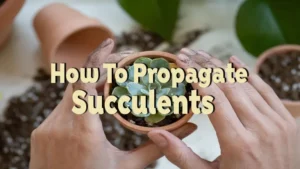





Leave your comment